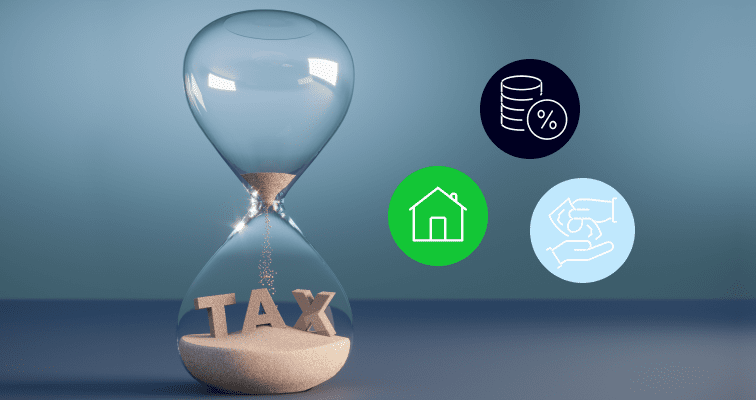In Sweden, when you sell financial assets, there is the possibility that you may need to pay capital gains tax (CGT) on any profits you make. Find out what CGT is, how it works, and what you should know to ensure that you comply with legal requirements while protecting your investments.
The process of buying stocks is made relatively straightforward by online trading platforms that provide a user-friendly way of depositing funds with a trusted broker and gaining exposure to the financial markets. Selling those investments, however, is not always so straightforward.
In Sweden, if you sell an asset at a price that is higher than that which you paid for it, the difference between the revenue and the expenditure is termed a “capital gain.” In many cases, the Swedish tax agency (Skatteverket) will require that you pay capital gains tax (CGT) on this capital gain.
The tax situation in Sweden might seem complex, but this guide will help you to navigate the process seamlessly. It explains what Swedish CGT is, how to calculate and report it, and how to ensure that you pay no more than the legal requirement.
What is capital gains tax (CGT)?

Capital gains tax is a levy incurred on returns from the sale of any
In Sweden, different assets are taxed in different ways. The flat-fee CGT rate is widely applied as 30% of the profits on any trade. However, other factors also come into play. The amount of CGT you pay will be determined not only by national tax rates, but also your personal circumstances. These include the type of asset involved, whether or not it was held in a tax-efficient investment fund, and (regardless of where), the length of time you have held an investment.
Tip: Returns from longer-term holdings generally have more favourable CGT-rates than short-term trades.
Investors should also consider capital losses. Not all trades are profitable, and sometimes investors lose money. In Sweden, certain losses on bad trades can be
It is your obligation to understand how capital gains tax works in Sweden. You need to file reports and pay CGT according to strict guidelines, and you may be liable for fines or penalties if you do not comply.
Developing a better understanding of how CGT works in Sweden can help to instil confidence in your approach to personal finance, and present opportunities to reduce your overall tax burden.
What assets have capital gains tax (CGT)?
The starting point for your capital gains tax analysis is to establishg which of your investments fall into the scope of CGT, and what taxation rates apply to them. In Sweden, items classed as capital assets range from shares listed on the Stockholm stock exchange (Nasdaq Stockholm) to other assets such as real estate and crypto. While not an exhaustive list, investors in Sweden will usually have to pay capital gains tax on profits made when they sell the following assets:
- Shares, units and similar investments
- CFDs and derivatives
- Corporate bonds
- Interest on savings
- Foreign endowment policies, such as life insurance policies and foreign pension insurance
- Dividends
- Cryptoassets
- Currency trades
- Rental income
- Foreign shares bought as a tax resident in Sweden. Even for those who leave Sweden to live in another country, there may be capital taxes to pay for up to 10 years post-departure. If the country you move to has a double taxation agreement (DTA) with the Swedish authorities, you may find that you are taxed at more favourable terms.
- Private and commercial real estate (27%), including your primary residence (22%)
- The sale of personal items with a value greater than SEK50,000
At the other end of the spectrum, in Sweden, CGT-exempt assets may include:
- Gains made by Swedish corporate entities when they dispose of shares held for business reasons
- Personal items with a value lower than SEK50,000. This is an annual allowance.
- Assets held in an investment savings account (Swedish Investeringssparkonto, ISK)
- A percentage of tax may be deferred on a private home sale if funds are being used to purchase a new primary residence.
- Share sales if the seller holds at least 10% of the shares or the shares are unlisted
- Private pensions may receive favourable CGT tax rates.
How do I calculate my CGT?
Capital gains tax can be complicated — especially if you are trying to calculate the CGT liability across multiple asset groups or offsetting losses against profits.
The core factors to remember when calculating CGT in Sweden are that in most instances, the amount of tax is determined by the 30% flat rate system, and that your tax may be withheld and paid at source, by your broker.
If you want to calculate your CGT obligations yourself, there are four key stages to consider:
- Work out your basis: This is the purchase price of the asset plus any commissions or fees you paid. Remember to factor in any reinvested dividends, which can increase the basis over time.
- Calculate your realised capital gain: This is simply the price you sold the asset for, less any fees or commissions that formed part of the transaction.
- Determine the difference: Subtract the realised amount from the basis to establish whether you have made a capital gain or a capital loss.
- Keep track of the deadlines for filing returns and paying the Skatteverket: The tax year runs from January to December and the deadline for submitting your tax filing is May 2 in the following year.
Consider contacting Skatteverket directly to discuss your CGT situation. The advice offered is free and the tax authority is the primary source of all Swedish tax information.
While the 30% flat rate of CGT applies to a large percentage of asset groups, there are some assets that are taxed differently, such as:
- CGT rates on your primary residence are, for example, 22%.
- The effective tax rate on capital transactions varies according to how long you have held them.
- Foreign endowment policies (such as life insurance policies and foreign pension insurances) that are owned by an individual fall outside the flat rate scheme. These are generally subject to an annual yield tax, which considers the value of the holding, rather than whether you
liquidated any of your positions.
The most straightforward
How does CGT impact my other investments?

If you sell an asset where CGT is applicable, a CGT event will occur. You may need to file a tax return and pay Skatteverket the required amount of tax. The process of submitting your tax return involves completing the Inkomstdeklaration 1 report.
It is your responsibility to check that the details are correct before confirming that the statement is accurate and submitting it.
Another way that CGT might impact your investment approach relates to strategy planning. Investors might be attracted to the idea of investing in tax-free vehicles, such as an ISK — an investment scheme that protects you from the full extent of CGT.
It should be noted that there is an annual wealth tax-style charge of 0.447% on the notional value of your account, which is levied even if your portfolio falls in value during the tax year. Despite this, an ISK typically compares favourably to the 30% flat CGT fee on standard stock transactions.
If you are an active trader who buys and sells many shares many times throughout the year, are new to investing, or have an established diversified portfolio, it may be wise to get advice from an experienced tax advisor to make sure that you don’t miss any of your CGT liabilities.
Whether you plan to manage your own CGT liabilities, or seek advice from an expert, it is crucial to keep a record of all transactions, including shares and any other investments. Information that is worth keeping safe includes:
- Details of share dealing transactions
- Details of charges relating to any money you borrowed to finance capital investments
- Statements detailing brokerage fees
- Accounting and legal costs
- Valuations, especially of illiquid assets
How can I minimise my CGT burden?

While you may not be able to avoid paying capital gains tax entirely, there are strategies you can use to minimise the amount of CGT you pay each financial year.
Take advantage of capital losses
Not all trades will be winners. Capital losses on bad trades can be offset against gains on profitable ones to reduce your overall tax burden. Note, however, that in Sweden, only losses on instruments that are similar in nature can be netted off against each other, and it is likely that only 70% of any losses can be applied against gains.
Take advantage of tax-efficient investment schemes
Investments held in certain individual savings accounts are exempt from CGT. A “standard revenue” charge based on a hypothetical return is applied, but this is typically lower than the 30% CGT flat fee.
Stagger the sale of personal items
The SEK50,000 allowance on the sale of personal items renews each year. If you are in a position to
For example, imagine your successful investments stand to make SEK10,000 profit overall in one tax year. Rather than selling each position within the same year, and realising your entire SEK10,000 capital gain that year, you might choose to sell half of the positions now, and hold on to the rest until later down the line, in a new tax year, to exit the market gradually. By taking smaller amounts of profit out of your investments at one time, you can reduce your CGT-burden within any one tax year.
Speak to a professional
A tax agent with experience of helping investment clients can give you personalised advice on how to best reduce your CGT liability. An expert can help you to be more confident that your tax-efficiency campaign optimises returns, but doesn’t breach the terms of the tax code.
Final thoughts
Capital gains tax is an unavoidable part of being an investor in Sweden. The flat-fee approach makes most CGT events relatively easy to process, but if you do have more complex investments, then understanding the workings of the tax code on those items can be challenging. However, time devoted to understanding your obligations can help you to have more confidence that you are compliant with all of the necessary protocols and can even present opportunities to reduce your overall CGT liability.
Once you have a clearer understanding of how CGT works, you can focus on picking the right investments to help you to gain financial freedom. CGT is, after all, only paid on profitable trades.
Join eToro today and learn more about CGT, investing in shares and trading in general.
FAQs
- What is the best way to keep track of my transactions and statements?
-
The broker or bank that holds your investments will be set up to provide detailed reports on your transactions and capital gains. You’ll find these in the account admin area of your online account. Some brokers offer additional support such as tax statements, which can be really useful as they give a ready-made summary of your investment activity.
- Is there a “wealth tax” in Sweden?
-
No. Sweden did operate a wealth tax system until 2007, but since then, CGT events have been triggered by sales of capital assets — and a tax charge applied to the profits on that sale. A wealth tax, in contrast, considers your total net worth and applies an arbitrary tax rate on your holdings, regardless of whether you sell them or not.
- Who makes the payment of CGT to the tax authority?
-
This depends on what assets you are investing in. If you sell stocks and have a CGT liability, then you must file a tax report with the Skatteverket. Sales of items such as art, which are less likely to be recorded in a widely used reporting system, would have to be referenced in your annual tax return, and payment made according to the tax agency’s timelines.
This information is for educational purposes only and should not be taken as investment advice, personal recommendation, or an offer of, or solicitation to, buy or sell any financial instruments.
This material has been prepared without regard to any particular investment objectives or financial situation and has not been prepared in accordance with the legal and regulatory requirements to promote independent research. Not all of the financial instruments and services referred to are offered by eToro and any references to past performance of a financial instrument, index, or a packaged investment product are not, and should not be taken as, a reliable indicator of future results.
eToro makes no representation and assumes no liability as to the accuracy or completeness of the content of this guide. Make sure you understand the risks involved in trading before committing any capital. Never risk more than you are prepared to lose.


